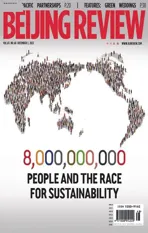Understanding China’s Development Model
2022-12-26BySajjadMalik
By Sajjad Malik
The path of China’s economic progress has for years been under discussion as an alternative for use by other developing countries to expedite development and pull millions out of poverty.Before going into its merits, it is first important to understand the model.
The key component of China’s economic philosophy is that it espouses a development path with Chinese characteristics. China believes every country should identify its own development needs and chalk out policies and action plans to meet them rather than following a one-size-fits-all model. Coordinated efforts will lead to win-win cooperation worldwide.
However, in a globalized world, different states are intertwined with each other in terms of politics, economics, finance, technology and culture. Countries and peoples are interconnected and interdependent and therefore need to seek more ways to ensure this interconnectedness supports common development.
In his report to the 20th Communist Party of China National Congress, a milestone political event that outlined priorities in the next five years and beyond, in October, President Xi Jinping reiterated China’s commitment to its fundamental national policy of opening to the outside world.
“It strives to create new opportunities for the world with its own development and to contribute its share to building an open global economy that delivers greater benefits to all peoples,” he said.
Basing policies around the central concept of win-win cooperation for a shared future creates a powerful driver for a nation’s economic development. During the course of its development,China has offered mutually beneficial trade partnerships to many other nations.
The Belt and Road Initiative,which aims to enhance connectivity along and beyond the ancient Silk Road routes, is one example of this concept in practice on a global scale. Approximately 150 countries have become part of the initiative and are benefiting from the cooperation it fosters.
The initiative now touches more than one third of the world’s GDP and trade and close to two thirds of the world’s population. China, through the initiative, has helped unlock trade opportunities for landlocked countries including Nepal, Laos and Afghanistan, which have enormous potential but negligible shares in global trade. The Belt and Road Initiative is revolutionizing the concept of connectivity by exploring new channels for the transportation of goods, reducing the time and cost of trade,and offering tremendous dividends to regions and societies by putting them on trading routes.
Its success shows that China’s vision of development and governance is helping bolster global confidence, as its priority lies in common prosperity, joint contribution with other nations, and a shared future for humanity.
The support garnered from such a diverse array of nations lies in the fact that the Belt and Road Initiative tries to directly address the threats and challenges currently posed to human economic security.
Poverty is one of the biggest problems facing many nations. China has raised more than 770 million people out of absolute poverty over the past 40-plus years, which is a giant leap toward eliminating poverty globally.
This is a manifestation of China’s development philosophy, which prioritizes the improvement of people’s wellbeing.The philosophy not only improves livelihoods but also brings social stability, thus offering a favorable setting that allows a society to achieve quick economic progress and prosperity.
In a time of rising unilateralism, China says it is committed to promoting multilateral cooperation to help the developing world with resources and technologies. It is also opening its door wider for imports and attracting more investment.
China’s development model likens the world to a giant ship, prompting the country to make efforts for the good of the entire human race. Such efforts should be encouraged as they are needed more than ever to expedite global economic recovery in the postpandemic era. BR
